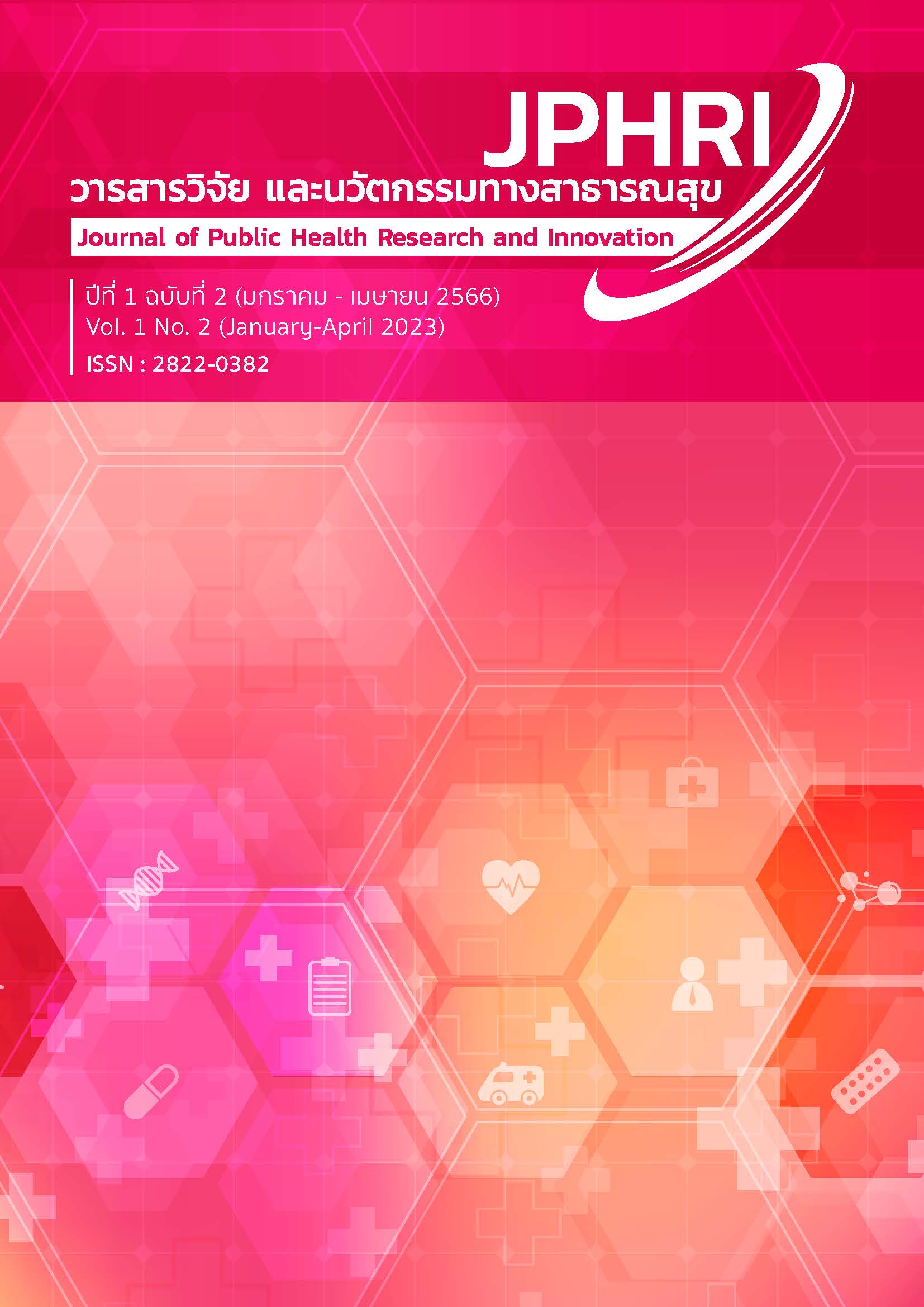การศึกษาย้อนหลังเปรียบเทียบภาวะโภชนาการของผู้ป่วยโรคหลอดเลือดหัวใจ ก่อนและหลังการได้รับโภชนศึกษา
Main Article Content
บทคัดย่อ
บทนำ: โรคหลอดเลือดหัวใจเกิดจากการอุดตันของไขมันในหลอดเลือด สาเหตุสำคัญเกิดจากการรับประทานอาหารที่ไม่เหมาะสม การได้รับโภชนศึกษาจะช่วยส่งเสริมการปรับเปลี่ยนพฤติกรรมให้เหมาะสมกับภาวะโภชนาการ ปัจจุบันในประเทศไทยยังไม่มีการศึกษาพฤติกรรมการรับประทานอาหารร่วมกับภาวะโภชนาการ
วัตถุประสงค์: เพื่อศึกษาภาวะโภชนาการและพฤติกรรมการบริโภคอาหารในผู้ป่วยโรคหลอดเลือดหัวใจ ก่อนและหลังการได้รับโภชนศึกษา
วิธีการศึกษา: การศึกษาแบบย้อนหลังโดยใช้ข้อมูลจากเวชระเบียนของผู้ป่วยโรคหลอดเลือดหัวใจที่มารับบริการที่แผนกผู้ป่วยนอก คลินิกโรคหลอดเลือดหัวใจ โรงพยาบาลสุราษฎร์ธานี ในช่วงระหว่าง มกราคม-ธันวาคม พ.ศ.2564 ที่มีข้อมูลผลตรวจทางห้องปฏิบัติการผิดปกติ และถูกส่งปรึกษานักโภชนาการ โดยสุ่มตัวอย่างแบบเจาะจงในการคัดเลือกข้อมูลผู้เข้าร่วมวิจัยจำนวน 33 คน เครื่องมือที่ใช้ในการวิจัยเป็นแบบสอบถามแบ่งออกเป็น 2 ชนิด คือ 1) แบบบันทึกข้อมูลย้อนหลังจากเวชระเบียน ประกอบด้วย ข้อมูลพื้นฐาน และข้อมูลลักษณะทางคลินิกของผู้ป่วย และ 2) แบบสอบถามประเมินพฤติกรรมการบริโภคอาหาร โดยมีค่าความเที่ยงของเครื่องมือค่าสัมประสิทธิ์อัลฟาของครอนบาค เท่ากับ 0.86 และวิเคราะห์ข้อมูลด้วยสถิติเชิงพรรณนาและใช้สถิติ paired t-test
ผลการศึกษา: หลังการให้โภชนศึกษาในผู้ป่วย พบว่า ระดับ Total cholesterol (p=0.004) ระดับ Low density lipoprotein-cholesterol (LDL- cholesterol) (p<0.001) และระดับน้ำตาลในเลือด (p=0.047) ของผู้ป่วยลดลงอย่างมีนัยสำคัญทางสถิติ รวมถึงผู้ป่วยมีค่าเฉลี่ยคะแนนพฤติกรรมการบริโภคอาหารดีขึ้นอย่างมีนัยสำคัญทางสถิติ(p<0.001) หลังได้รับ
โภชนศึกษา เมื่อเปรียบเทียบกับก่อนได้รับโภชนศึกษา
สรุปผล: การให้โภชนศึกษามีผลให้ภาวะโภชนาการ และพฤติกรรมการบริโภคอาหารของผู้ป่วยดีขึ้นสามารถช่วยลดโอกาสการเกิดโรคที่รุนแรง จึงสามารถนำมาประยุกต์ใช้เพื่อดูแลผู้ป่วยโรคหลอดเลือดหัวใจได้
Article Details

อนุญาตภายใต้เงื่อนไข Creative Commons Attribution-NonCommercial-NoDerivatives 4.0 International License.
เอกสารอ้างอิง
Ralapanawa U, Sivakanesan R. Epidemiology and the Magnitude of Coronary Artery Disease and Acute Coronary Syndrome: A Narrative Review. J Epidemiol Glob Health. 2021; 11(2): 169-77.
Tsao CW, Aday AW, Almarzooq ZI, Alonso A, Beaton AZ, Bittencourt MS, et al. Heart disease and stroke statistics—2022 update: a report from the American Heart Association. Circulation. 2022; 145(8): e153-e639.
Department of Disease Control. Situation of Coronary Artery Disease (CAD) in 2018. 2018. Available at: h t t p s : / / d d c . m o p h . g o . t h / d o e / n e w s . php?news=10811. Accessed on 25 December 2022.
Ignatavicius DD, Workman ML, Rebar C. Medical-Surgical Nursing-E-Book: Concepts for Interprofessional Collaborative Care: Elsevier Health Sciences; 2017.
Arnold SV, Bhatt DL, Barsness GW, Beatty AL, Deedwania PC, Inzucchi SE, et al. Clinical Management of Stable Coronary Artery Disease in Patients With Type 2 Diabetes Mellitus: A Scientific Statement From the American Heart Association. Circulation. 2020; 141(19): e779-e806.
Safabakhsh L, Jahantigh M, Nosratzehi S, Navabi S. The Effect of Health Promoting Programs on Patient’s Life Style After Coronary Artery Bypass Graft-Hospitalized in Shiraz Hospitals. Glob J Health Sci. 2015; 8(5): 154-9.
Panarat Srichaya, Pachanut Nunthaitaweekul, Aungsuroch Y. Predicting Factors of Dietary Behaviors in Patients with Coronary Artery Disease. Royal Thai Navy Medical. 2019; 45(3): 527-43. (in Thai)
Chueybudda S. Factors Affected to Risk of Cardiovascular Disease Among People aged over 35 year old in Nong Bua subdistrict, Ban Fang District, Khon Kaen. Community Health Development Quarterly Khon Kaen University. 2015: 547-60. (in Thai)
Wilson PW, D’Agostino RB, Levy D, Belanger AM, Silbershatz H, Kannel WB. Prediction of coronary heart disease using risk factor categories. Circulation. 1998; 97(18): 1837-47.
Howard BV, Ruotolo G, Robbins DC. Obesity and dyslipidemia. Endocrinol Metab Clin North Am. 2003; 32(4): 855-67.
Mozaffarian D, Benjamin EJ, Go AS, Arnett DK, Blaha MJ, Cushman M, et al. Heart disease and stroke statistics--2015 update: a report from the American Heart Association. Circulation. 2015; 131(4): e29-322.
Khatun T, Maqbool D, Ara F, Sarker MR, Anwar KS, Hoque A. Dietary habits of patients with coronary artery disease in a tertiary-care hospital of Bangladesh: a case-controlled study. J Health Popul Nutr. 2021; 40(1): 1-6.
Eshah NF, Bond AE, Froelicher ES. The Effects of a Cardiovascular Disease Prevention Program on Knowledge and Adoption of a Heart Healthy Lifestyle in Jordanian Working Adults. Eur J Cardiovasc Nurs. 2010; 9(4): 244-53.
Brown JC, Gerhardt TE, Kwon E. Risk Factors For Coronary Artery Disease. StatPearls. Treasure Island (FL): StatPearls Publishing; 2023.
Luisi MLE, Biffi B, Gheri CF, Sarli E, Rafanelli E, Graziano E, et al. Efficacy of a nutritional education program to improve diet in patients attending a cardiac rehabilitation program: outcomes of a one-year follow-up. Intern Emerg Med. 2015; 10(6): 671-6.
Dos Santos H, Beeson WL, Segovia-Siapco G, Koranda B, Jehi T. Effects of nutrition education on cardio-metabolic outcomes: A randomised clinical trial. Health Educ J. 2020; 79(4): 458-70.
Wichitthongchai C, Lowirakorn S. Effect of Nutritional Education in Patients After Coronary Artery Bypass Graft Surgery at Queen Sirikit Heart Center of the Northeast, Faculty of Medicine, Khon Kaen University. Srinagarind Medical Journal. 2013; 28(2): 220-8. (in Thai)
Chow SC, Shao J, Wang H, Lokhnygina Y. Sample size calculations in clinical research: CRC press; 2017.
Ponpinij. P, Deenan. A, Wiseso. W. Factor Analysis of the Eating Behavior Questionnaire in Patient with Coronary Artery Disease. JFONUBUU. 2020; 28(2): 40-51. (in Thai)
Bloom RS. Stating educational objectives in behavioral terms. Nursing Forum. 1975; 14(1): 30-42.


